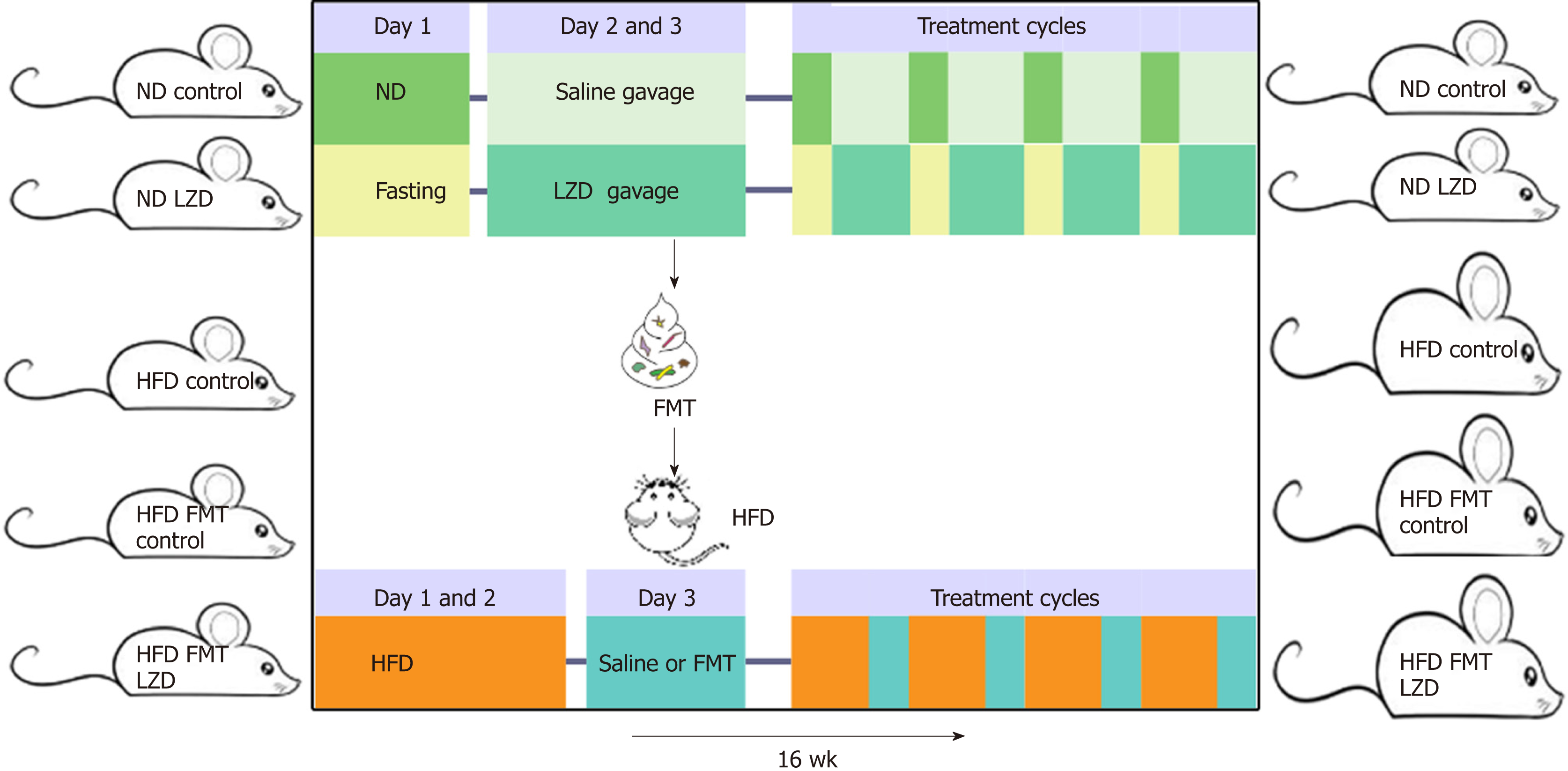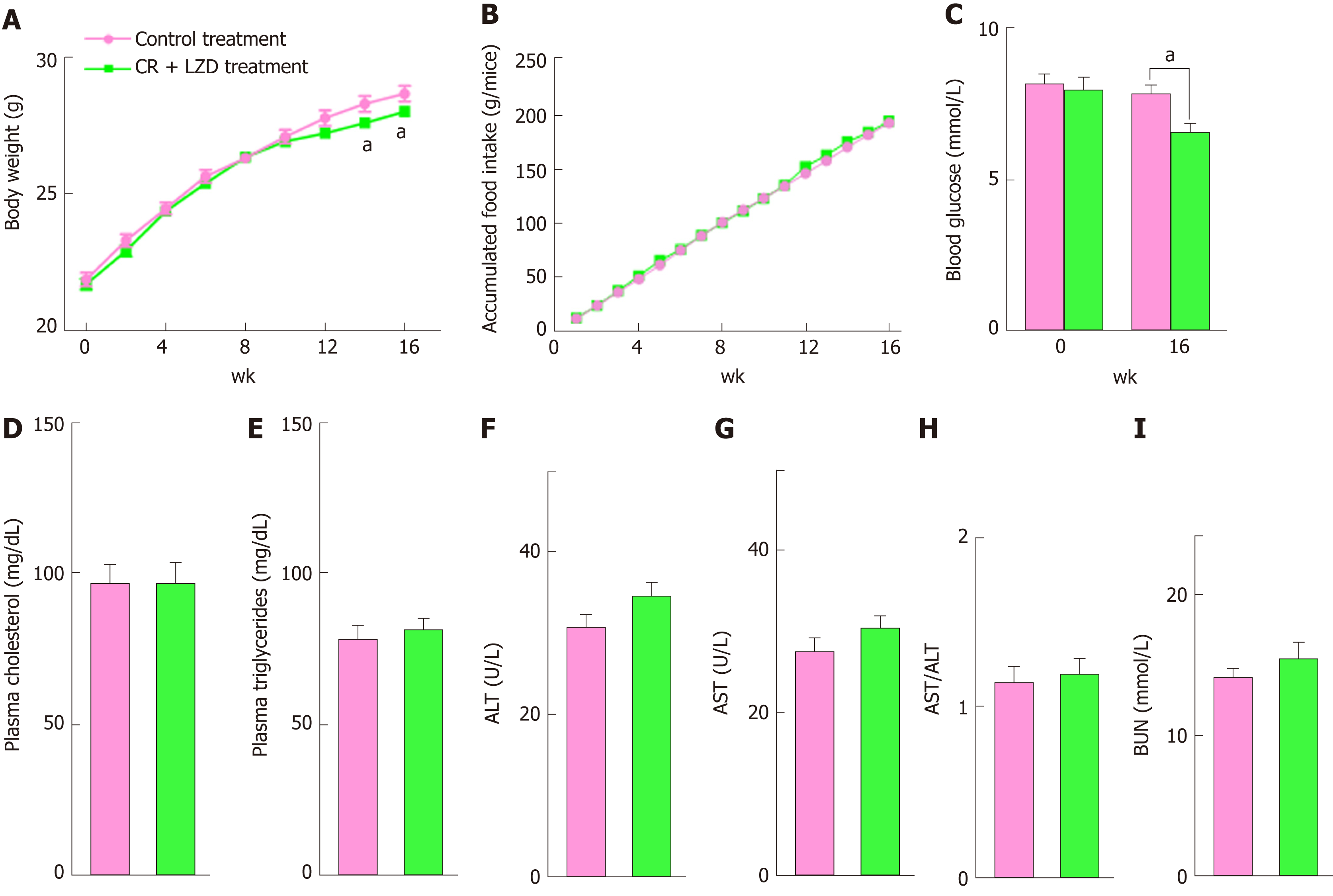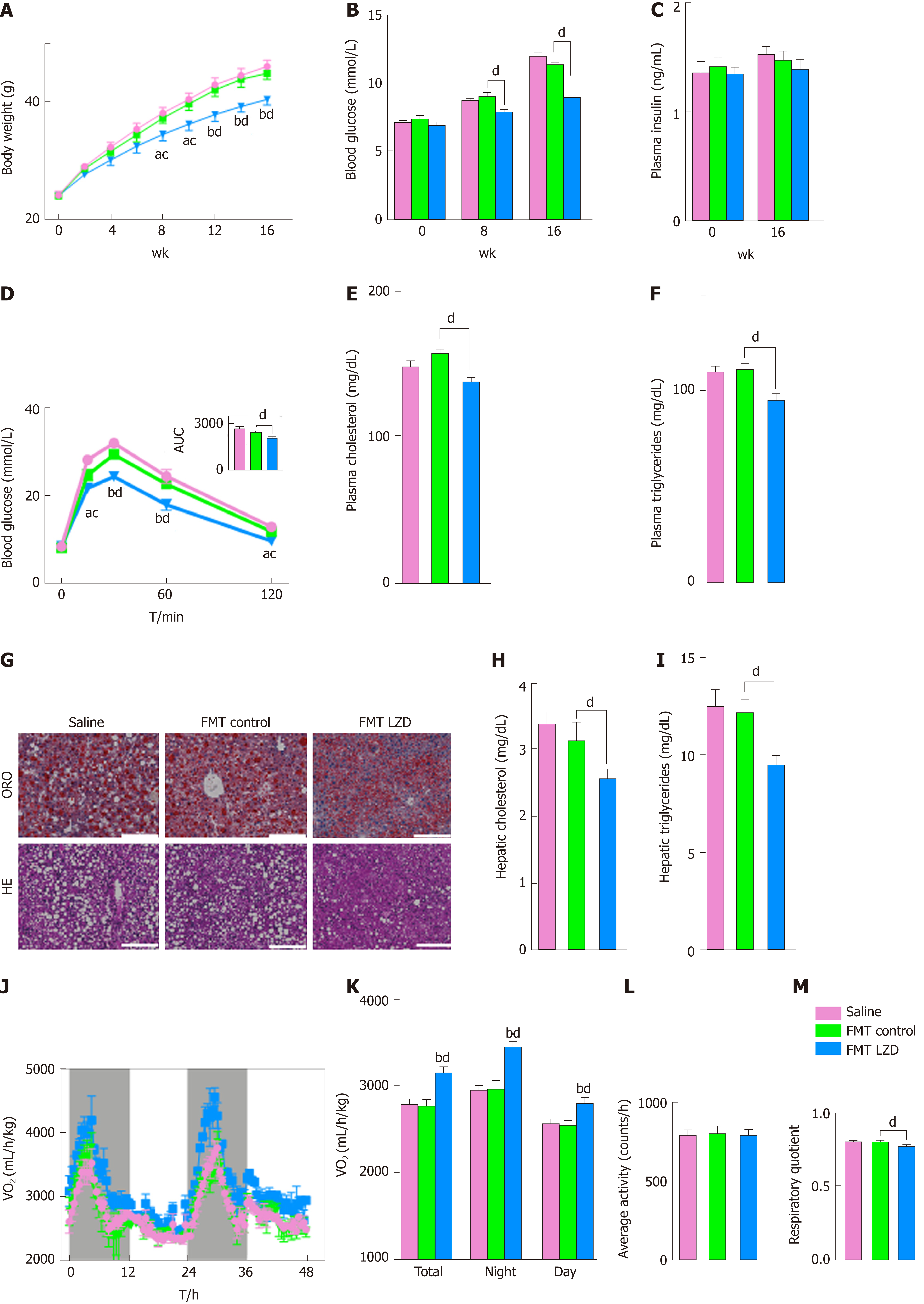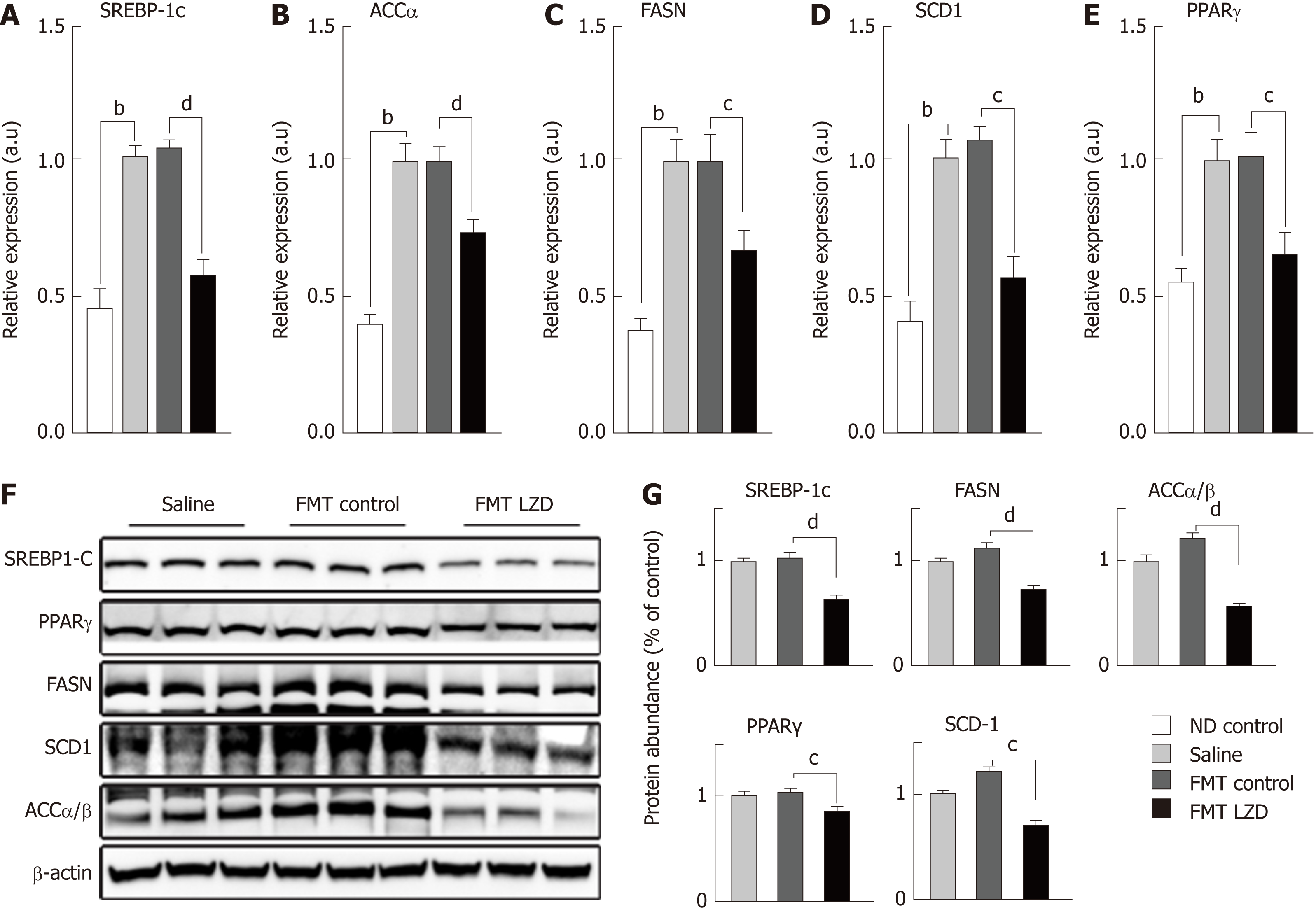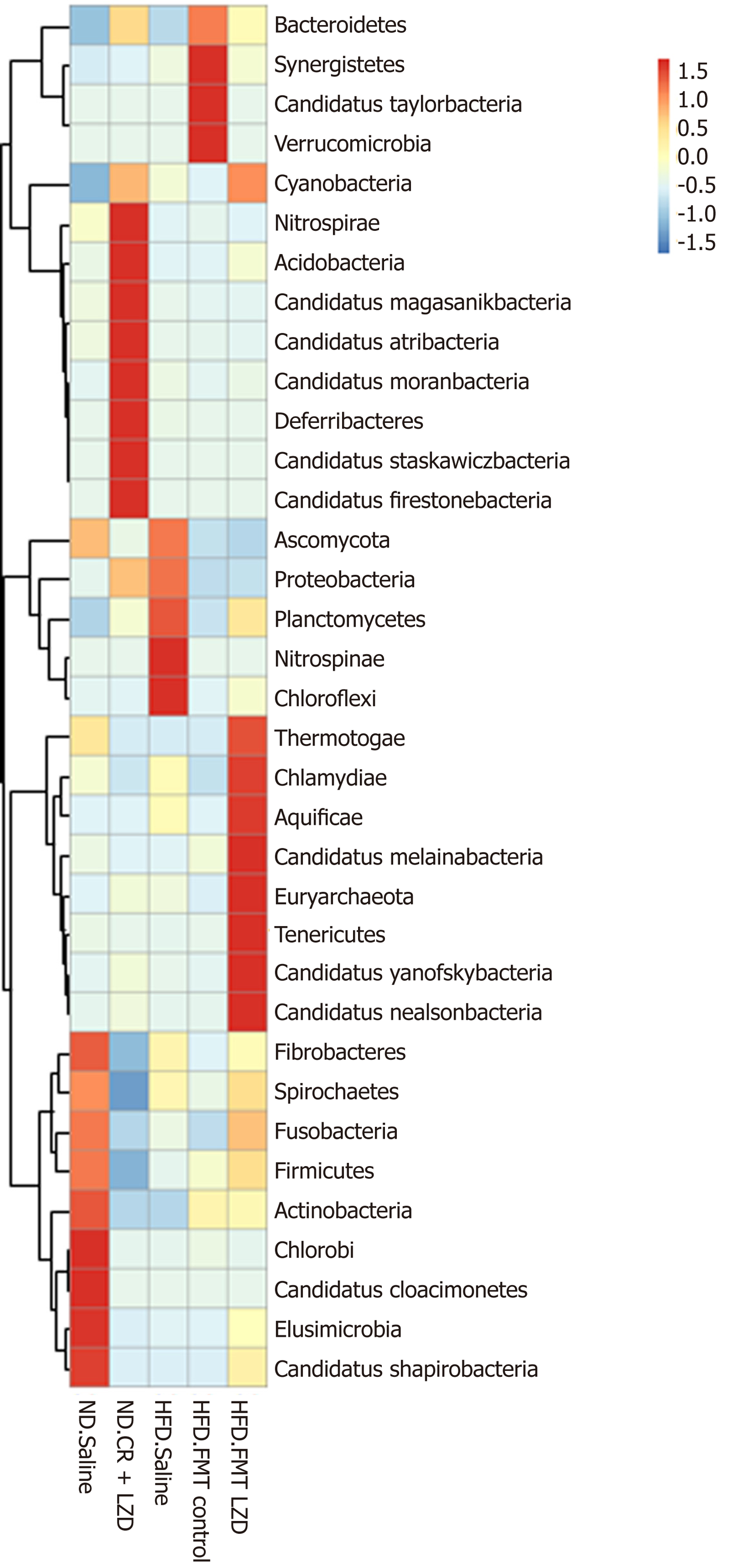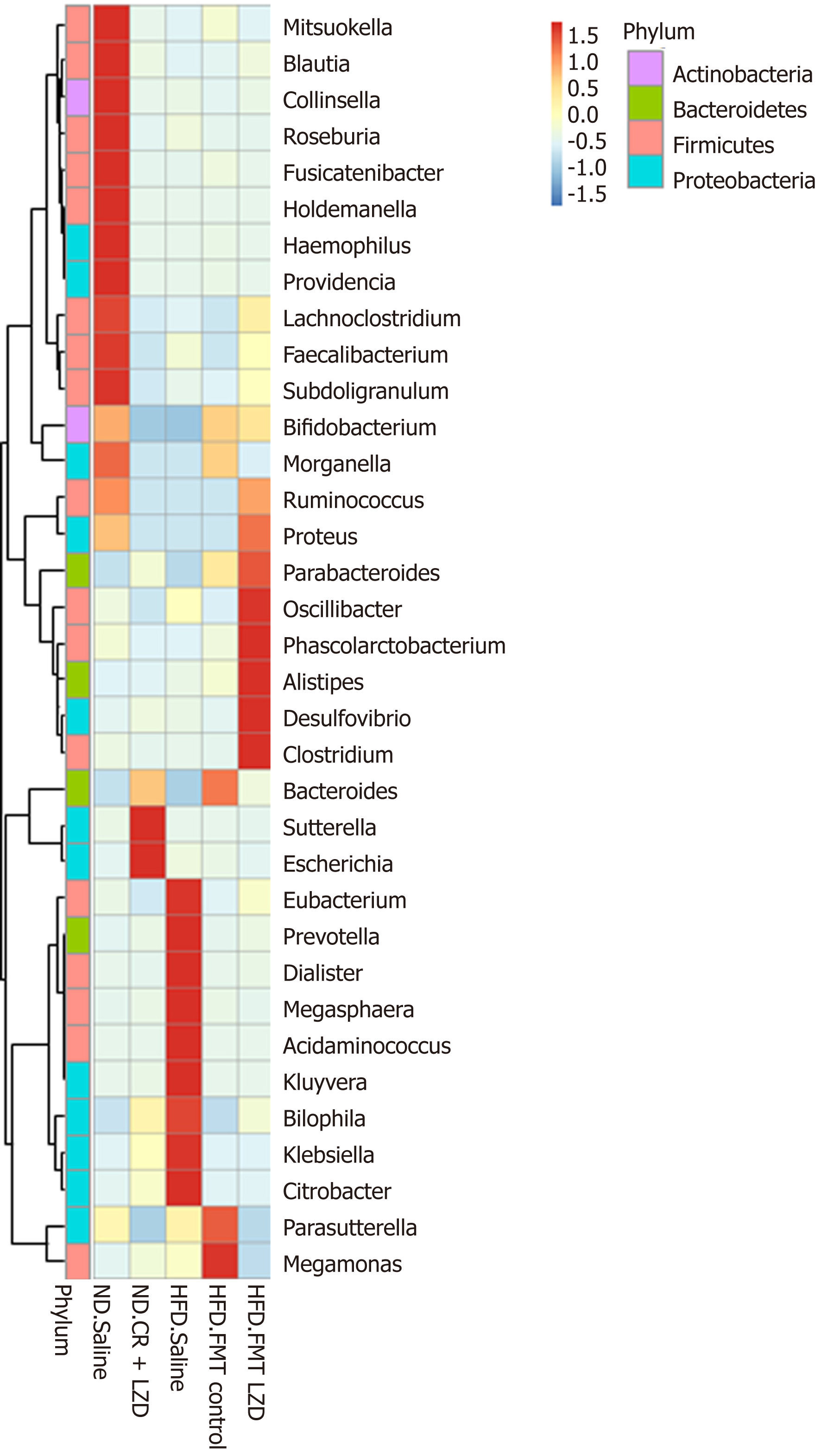Copyright
©The Author(s) 2019.
World J Gastroenterol. Jul 21, 2019; 25(27): 3590-3606
Published online Jul 21, 2019. doi: 10.3748/wjg.v25.i27.3590
Published online Jul 21, 2019. doi: 10.3748/wjg.v25.i27.3590
Figure 1 Illustration of experimental schemes.
ND: Normal diet; LZD: Lingguizhigan decoction; HFD: High-fat diet; FMT: Fecal microbiota transplantation.
Figure 2 Caloric restriction and Lingguizhugan decoction treatment reduces body weight and blood glucose levels in normal diet-fed C57BL/6J mice.
Eight-week-old male C57BL/6J mice received control treatment (pink) or caloric restriction and Lingguizhugan decoction (CR + LZD) (green) for 16 wk; n = 10 per group. A: Body weight was monitored biweekly during the study period, and each point and error represents the mean ± standard error; B: Accumulated food intake during experimental period; C: Fasting blood glucose levels were measured on weeks 0 and 16; D: Plasma total cholesterol levels; E: Plasma total triglyceride levels; F-H: Plasma alanine transaminase (ALT) and aspartate transaminase (AST) activity, and AST/ALT ratio; I: Plasma blood urea nitrogen levels. Data were evaluated for statistical significance by student’s t-test and are represented as follows: aP < 0.05 CR + LZD treatment vs Control treatment. CR: Caloric restriction; LZD: Lingguizhugan decoction; AST: Aspartate transaminase; ALT: Alanine transaminase; BUN: Blood urea nitrogen.
Figure 3 Fecal microbiota transplantation from caloric restriction and Lingguizhugan decoction-treated normal diet-fed mice into high-fat diet-fed C57BL/6J mice attenuates diet-induced obesity and hepatosteatosis.
Eight-week-old male C57BL/6J mice received saline gavage (denoted as Saline, pink), feces gavage from normal diet (ND)-fed control mice [denoted as fecal microbiota transplantation (FMT) control, green], or feces gavage from ND-fed mice receiving caloric restriction and Lingguizhugan decoction (CR + LZD) treatment (denoted as FMT LZD, blue) for 16 wk, and fed with HFD; n = 10 per group. A: Body weight was monitored biweekly during the experimental period, and each point and error represents the mean ± standard error; B: Fasting blood glucose levels were measured on weeks 0, 8 and 16; C: Plasma insulin levels were measured on weeks 0 and 16; D: Intraperitoneal glucose tolerance test was performed 1 wk prior to the end of the study. Glucose levels at each time point were compared by one-way ANOVA, and small letters indicate significant differences between FMT control and FMT LZD. Area under the curve was used to compare the overall differences between groups; E and F: Plasma total cholesterol (TC) and total triglycerides (TG) levels, respectively; G: Representative images of oil red O staining and hematoxylin and eosin staining of the liver (scale bar = 200 μm); H: Total cholesterol levels; I: Triglyceride levels; FMT control vs FMT LZD; J: Oxygen consumption of total test period, during the night, and during the day; K: Average oxygen consumption of total test period, during the night, and during the day; L: 24 h average physical activity; M: Respiratory quotient and of saline-treated, FMT control, and FMT LZD-treated mice were monitored with a metabolic monitoring system 3 d prior to death; n = 3 per group. Data were evaluated for statistical significance by one-way ANOVA and are represented as follows: aP < 0.05, bP < 0.01 FMT LZD vs Saline; cP < 0.05, dP < 0.01 FMT LZD vs FMT control. ND: Normal diet; LZD: Lingguizhigan decoction; HFD: High-fat diet; FMT: Fecal microbiota transplantation; AUC: Area under the curve; TC: Cholesterol; TG: Triglycerides; OCR: Oxygen consumption rate; ORO: Oil red O staining; HE: Hematoxylin and eosin staining.
Figure 4 Fecal microbiota transplantation from caloric restriction and Lingguizhugan decoction-treated normal diet-fed mice into high-fat diet-fed C57BL/6J mice reduces expression level and protein abundance of lipogenic genes.
Total RNA was isolated from liver samples from saline-treated mice (pink), fecal microbiota transplantation (FMT) control mice (green), and FMT Lingguizhigan decoction (LZD)-treated mice (blue). A-E: Gene expression was analyzed and normalized to 36B4 expression in the same sample; n = 10 per group; F: Representative blot of liver samples; G: Protein abundance of sterol regulatory element-binding protein 1c, peroxisome proliferator-activated receptor γ, fatty acid synthase, stearoyl-CoA desaturase 1, and acetyl-CoA carboxylase α/β was quantified and normalized to β-actin levels in the same lysate; n = 9 per group. Data were evaluated for statistical significance by one-way ANOVA and are represented as follows: aP < 0.05, bP < 0.01 vs normal diet control with Saline; cP < 0.05, dP < 0.01 FMT LZD vs FMT control. ND: Normal diet; LZD: Lingguizhigan decoction; HFD: High-fat diet; FMT: Fecal microbiota transplantation; SREBP: Sterol regulatory element-binding protein; ACC: Acetyl-CoA carboxylase; FASN: Fatty acid synthase; SCD: Stearoyl-CoA desaturase; PPAR: Peroxisome proliferator-activated receptor.
Figure 5 Relative abundance of gut microbes at phylum level.
ND. Saline: Mice fed with normal diet (ND) and given saline gavage; ND. CR + LZD: Mice fed with ND on caloric restriction (CR) and Lingguizhigan decoction (LZD) treatment; HFD. Saline: Mice fed high-fat diet (HFD) and given saline gavage; HFD. FMT control: Mice fed HFD and given fecal microbiota transplantation (FMT) from ND. Saline mice; HFD. FMT CR + LZD: Mice fed HFD and given FMT from ND. CR + LZD mice; ND: Normal diet; LZD: Lingguizhigan decoction; HFD: High-fat diet; FMT: Fecal microbiota transplantation; CR: Caloric restriction.
Figure 6 Relative abundance of gut microbiota at the family level.
ND. Saline: Mice fed normal diet (ND) and given saline gavage; ND. CR + LZD: Mice fed ND and given caloric restriction (CR) and Lingguizhigan decoction (LZD) treatment; HFD. Saline: Mice fed high-fat diet (HFD) and given saline gavage; HFD. FMT control: Mice fed HFD and given fecal microbiota transplantation (FMT) from ND. Saline mice; HFD. FMT CR + LZD: Mice fed HFD and given FMT from ND. CR + LZD mice; ND: Normal diet; LZD: Lingguizhigan decoction; HFD: High-fat diet; FMT: Fecal microbiota transplantation; CR: Caloric restriction.
Figure 7 Relative abundance of gut microbiota at the genus level.
ND. Saline: Mice fed normal diet (ND) and given saline gavage; ND. CR + LZD: Mice fed ND and given caloric restriction (CR) and Lingguizhigan decoction (LZD) treatment; HFD. Saline: Mice fed high-fat diet (HFD) and given saline gavage; HFD. FMT control: Mice fed HFD and given fecal microbiota transplantation (FMT) from ND. Saline mice; HFD. FMT CR + LZD: Mice fed HFD and given FMT from ND. CR + LZD mice; ND: Normal diet; LZD: Lingguizhigan decoction; HFD: High-fat diet; FMT: Fecal microbiota transplantation; CR: Caloric restriction.
Figure 8 Relative abundance of gut microbiota at species level.
ND. Saline: Mice fed a normal diet (ND) and given a saline gavage; ND. CR + LZD: Mice fed ND and given caloric restriction (CR) and Lingguizhigan decoction (LZD) treatment; HFD. Saline: Mice fed high-fat diet (HFD) and given saline gavage; HFD. FMT control: Mice fed HFD and given fecal microbiota transplantation (FMT) from ND. Saline mice; HFD. FMT CR + LZD: Mice fed HFD and given FMT from ND. CR + LZD mice; ND: Normal diet; LZD: Lingguizhigan decoction; HFD: High-fat diet; FMT: Fecal microbiota transplantation; CR: Caloric restriction.
- Citation: Liu MT, Huang YJ, Zhang TY, Tan LB, Lu XF, Qin J. Lingguizhugan decoction attenuates diet-induced obesity and hepatosteatosis via gut microbiota. World J Gastroenterol 2019; 25(27): 3590-3606
- URL: https://www.wjgnet.com/1007-9327/full/v25/i27/3590.htm
- DOI: https://dx.doi.org/10.3748/wjg.v25.i27.3590









